Alongside the Fujifilm X-T10 which we recently received here we also received a very unique and specialized lens – the Fujifilm XF56mm F1.2 R APD. In this review we will try and look at what special about this lens, how it performs and who might be the target audience for this lens.
The Fujifilm XF56mm F1.2 R APD is the more recent “sister” to the Fujifilm XF56mm F1.2 R lens with the difference being the APD at the end of the lens name. So what does the APD stands for and why should you care?
The simple answer is that APD stands for apodization (or apodization filter). So what does anapodization filter do? well according to Fuji’s website: “apodization filter smoothes the bokeh’s outlines. This combination of image sharpness and beautiful bokeh delivers portraits with a three-dimensional feel”. Well, that is the marketing talk, here is a more detailed explanation by photographer Matt Grum:
“An apodization element is simply a radial neutral density filter (that gets darker towards the edges) placed near the aperture stop. This causes each disc of light to fade out gradually toward the edges. This helps the individual discs blend together to produce much smoother bokeh. The blur you get is effectively the same as running a Gaussian blur over the image.
It would be possible to get a similar effect using a screw in filter on the front of the lens (just like you can get creative bokeh shapes) but it’s better done at the aperture stop as this wont increase vignetting.”
So now that you more or less understand what an apodization filter does and what is it good for you are probably asking yourself – are there any downsides to using one (otherwise all manufacturers should have used they by now, right?), well there are at least 3 disadvantages:
- You will lens will transmit 1 or even 2 stops less light than the f-stop suggests (see our explanation about T-stops around 3:05 min on the video).
- AF in low light situations might be slower/less accurate due to the reduced light getting into the sensor.
- Price – adding an apodization filter is complex and thus also expensive.
The Fujifilm XF56mm F1.2 R APD is not the first lens to include an apodization filter, however it is the first AF lens which has this filter – and thus it was interesting to see how much it really effects the AF (read/watch on for more on that).
The Fujifilm XF56mm F1.2 R APD – the first AF lens with and apodization filter
The Fujifilm XF56mm F1.2 R APD has a great build quality just like all the other XF lenses that we tested to date (at least the production units – pre-production units we played with sometimes have issues – but this is to be expected).
The lens has a weigh of just over 400 grams (14.1 oz~) and is relatively small although it is thick (and as we discovered it does not fit well with the new X-T10 – read our full review on the camera – as the camera is too short and the camera tends to wobble – Fujifilm does have a grip for the camera that should solve this issue).
The lens has two rings – a very very smooth focus ring (although it is a fly-by-wire type ring like all of Fuji’s lenses as far as we know). The second ring is the aperture ring and it moves in clicks. It has two sets of markings on it – the upper one is the f-stops starting at f/1.2 and all the way up to f/16 and the second one is (as far as we understand it) a T-stop markings which basically tells you how much light the lens can take in at every f/stop.
In the hand – the 56mm f/1.2 APD is fairly compact
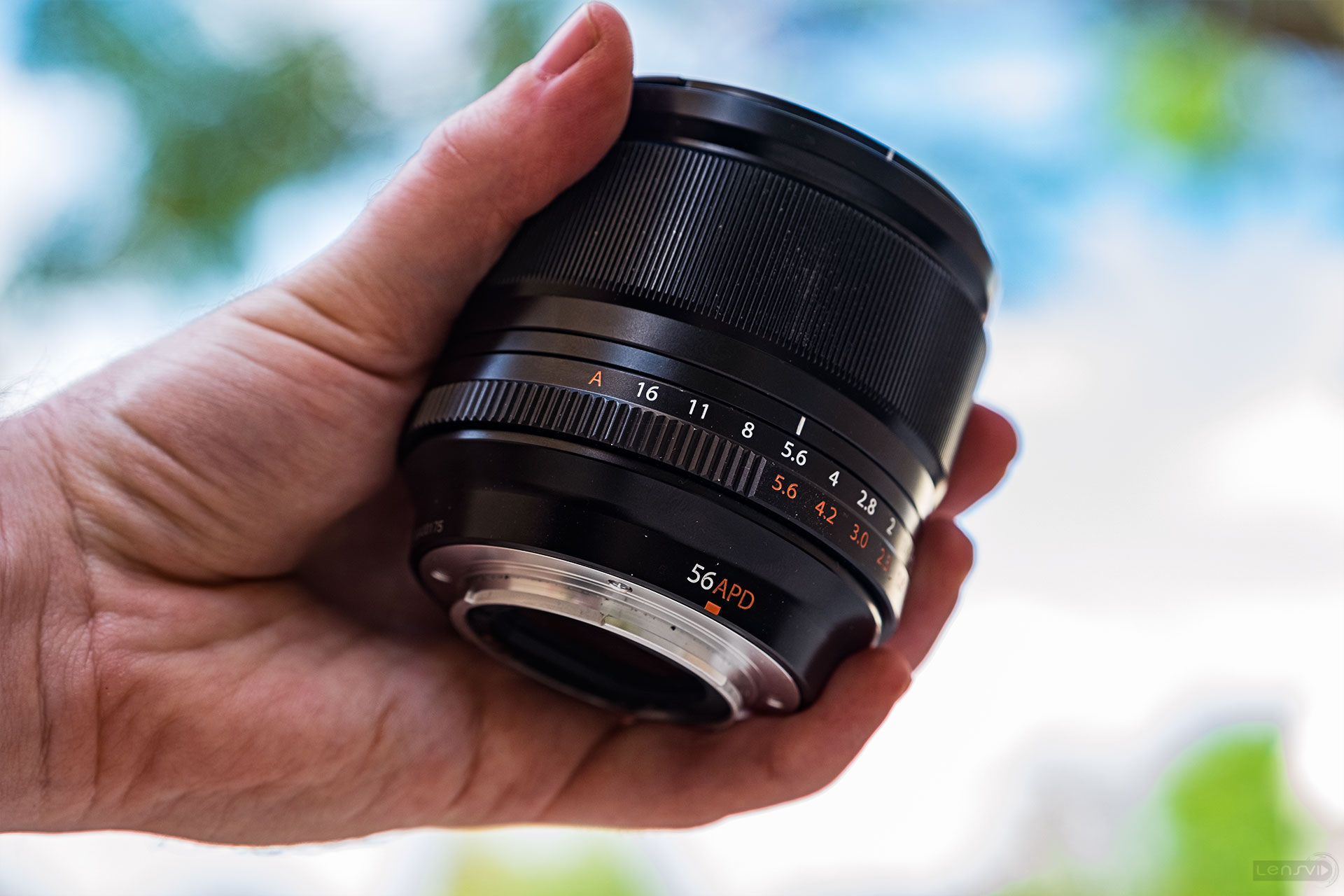 What you need to understand is that the apodization filter reduces the T-stop of the lens quite considerably – especially in larger apertures (so f/1.2 = T/1.7 for example).
What you need to understand is that the apodization filter reduces the T-stop of the lens quite considerably – especially in larger apertures (so f/1.2 = T/1.7 for example).
Performance
We can look at the Fujifilm XF56mm F1.2 R APD on its own and we can look at the performance compared to the non APD version. We really wanted to do a side by side but the non APD lens had some issues (we think that the one we got was a pre-production unit and it had some AF problems) so doing a real side by wasn’t an option. Quite a few other people have done a side by side testing which we would recommend reading – see this nicely done comparison for example.
So we are forced to looking at this lens on its own (we will make a few remarks based on what we did saw on the non APD version though).
Through the lens
 Vignetting – this is an interesting point on this lens (and also has something to to with Fuji in general). Initially we saw no vignetting at all (and this is what we also stated in the first part of the video). However when we looked for comparisons between the APD and non APD online some reviewers mentioned that this lens does have significant vignetting. This sounded strange to us and apparently we discovered that Fuji applies automatic correction of vignetting in its camera. However when looking at the RAW images you do see quite a bit of vignetting.
Vignetting – this is an interesting point on this lens (and also has something to to with Fuji in general). Initially we saw no vignetting at all (and this is what we also stated in the first part of the video). However when we looked for comparisons between the APD and non APD online some reviewers mentioned that this lens does have significant vignetting. This sounded strange to us and apparently we discovered that Fuji applies automatic correction of vignetting in its camera. However when looking at the RAW images you do see quite a bit of vignetting.
Sadly we can’t show you the RAW/JPEG images as due to some copying error on our part the images were not saved – but the vignetting is there in the RAW files and you can correct it to a degree in post.
Barrel distortion – the lens has no apparent barrel distortion (not too surprising for a 56mm lens), sadly just like the vignetting images, the Barrel distortion images were not saved.
Chromatic aberration – we never encountered any CA with the lens.
Sharpness – The Fujifilm XF56mm F1.2 R APD just like its non APD sister is extremely sharp especially in the center of the frame. We would go as far as to say that it is the sharpest lens that we tested which wasn’t a Zeiss lens – and this is saying a lot.
Center of the frame sharpness – f/1.2 (top left) to f/2.8 (bottom right)
 Center of the frame sharpness – f/2.8 (top left) to f/16 (bottom right)
Center of the frame sharpness – f/2.8 (top left) to f/16 (bottom right)
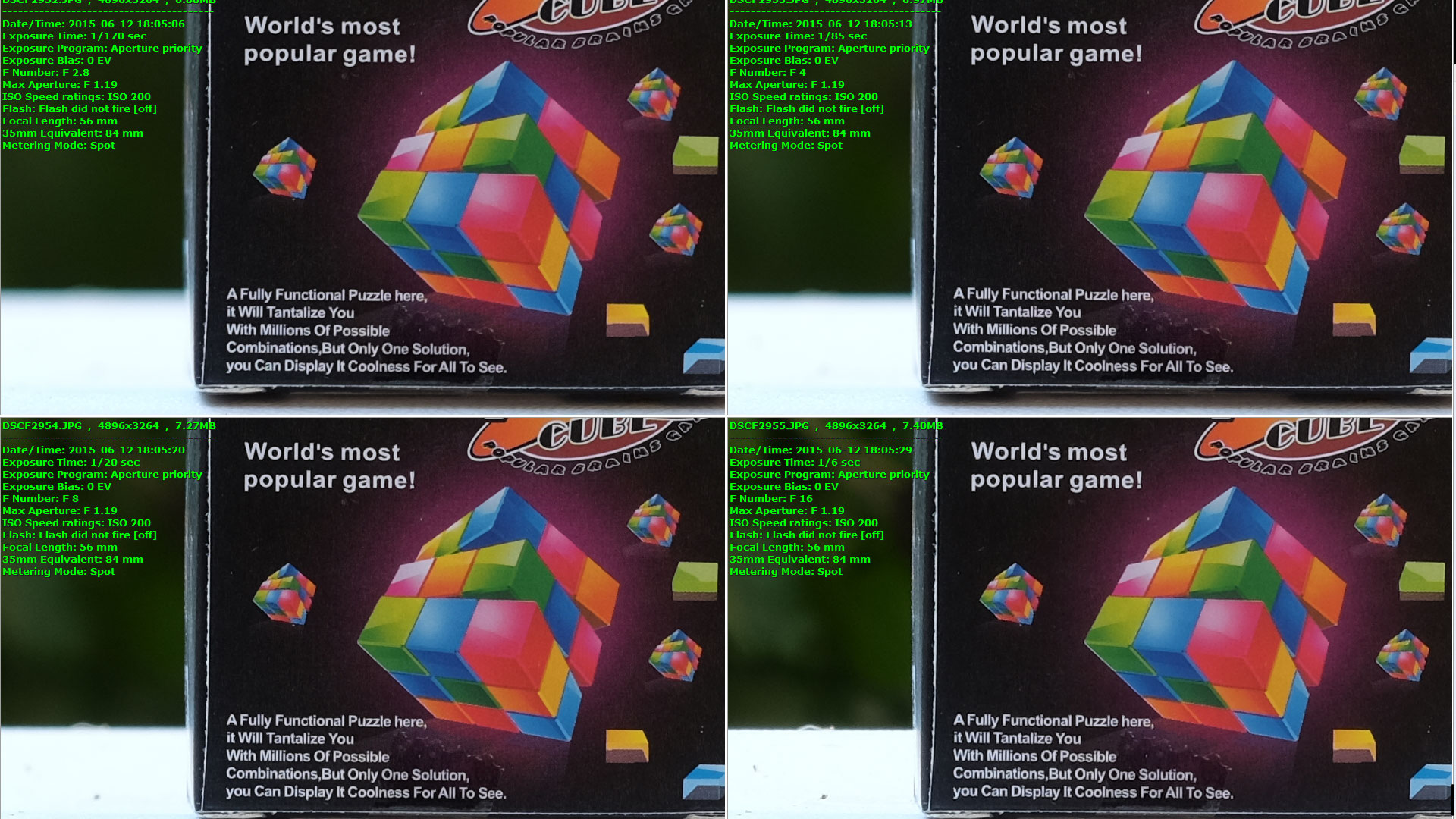 Left of the frame sharpness – f/1.2 (top left) to f/2.8 (bottom right)
Left of the frame sharpness – f/1.2 (top left) to f/2.8 (bottom right)
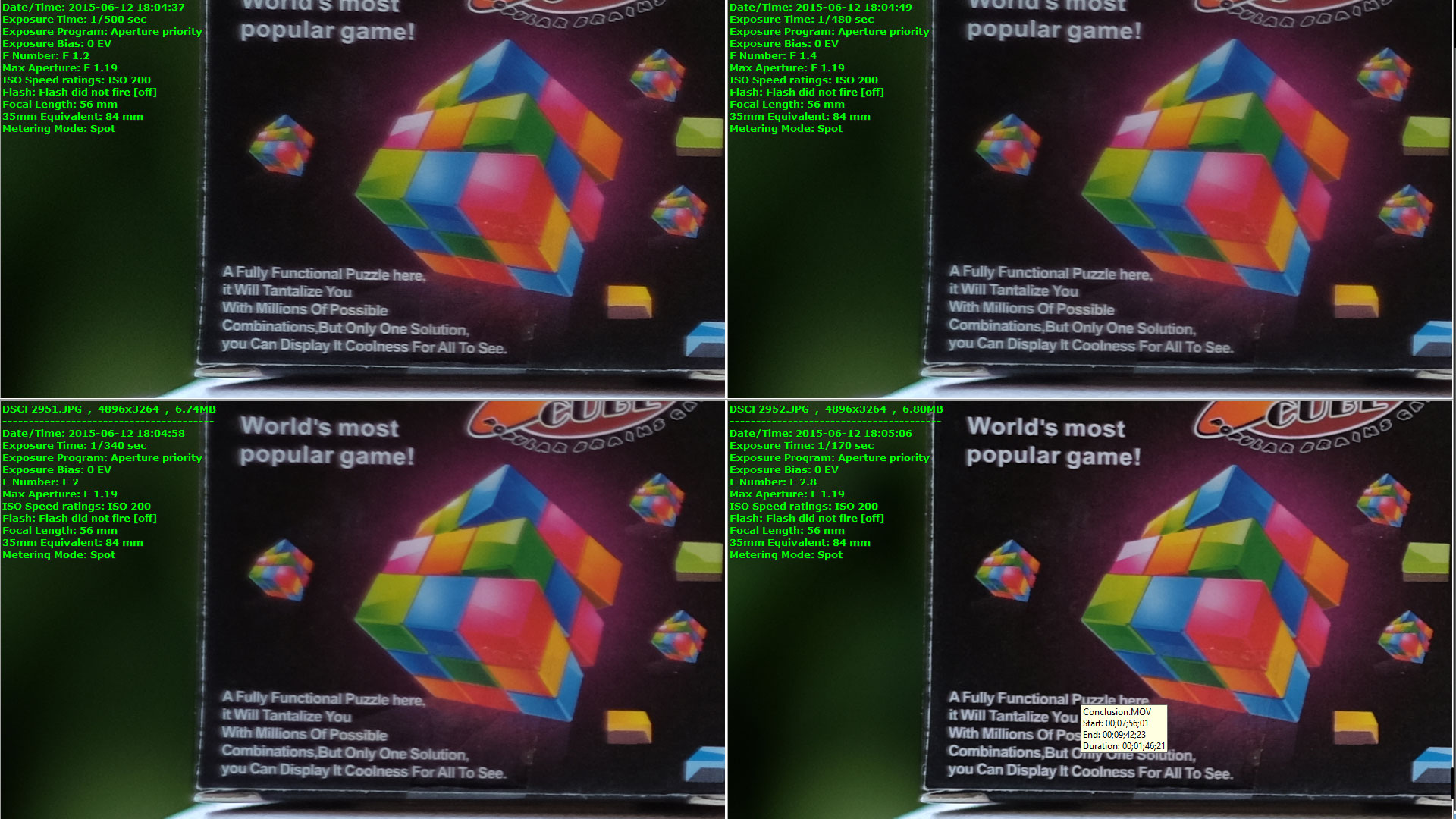 Left of the frame sharpness – f/2.8 (top left) to f/16 (bottom right)
Left of the frame sharpness – f/2.8 (top left) to f/16 (bottom right)
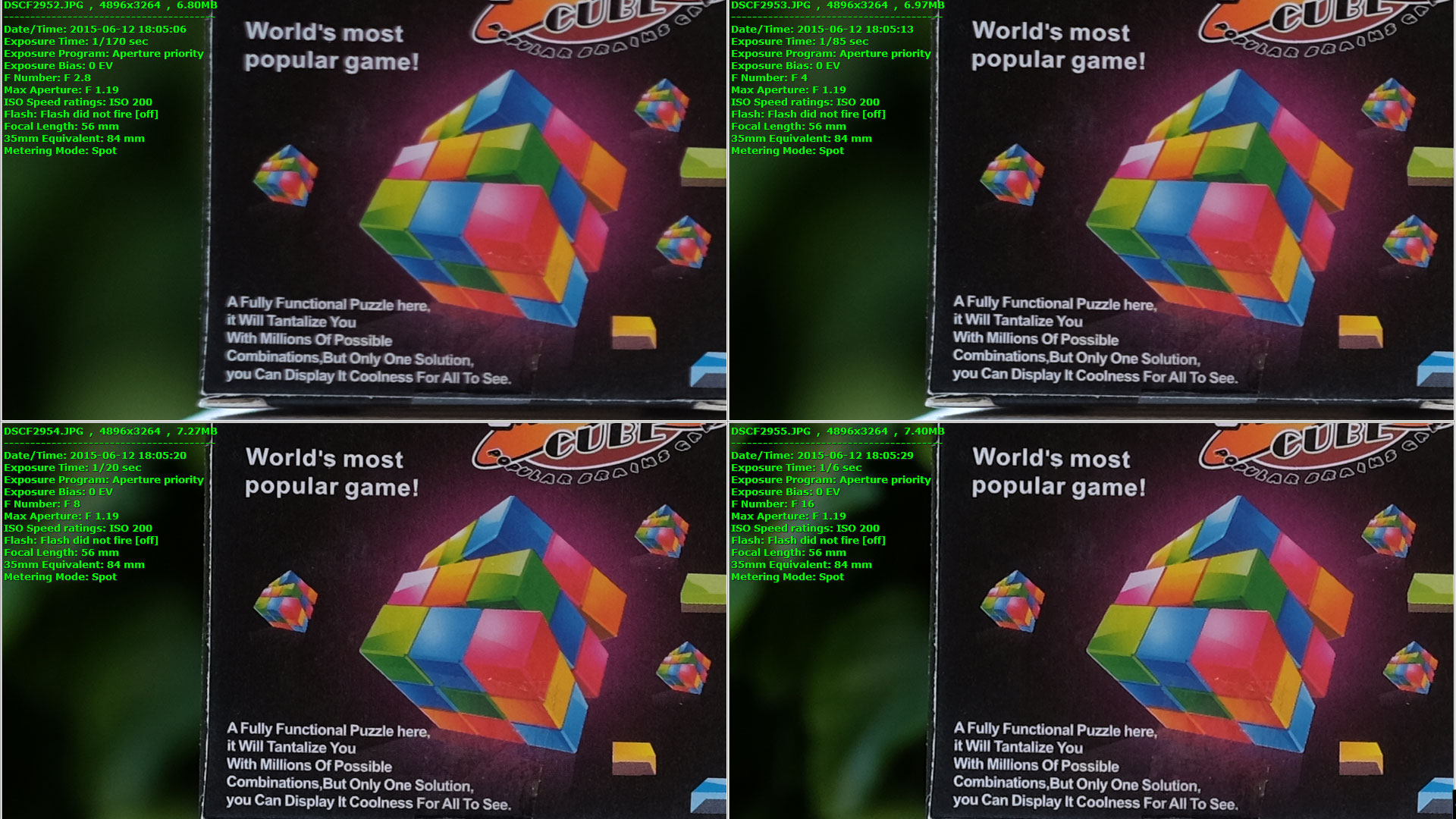 Right of the frame sharpness – f/1.2 (top left) to f/2.8 (bottom right)
Right of the frame sharpness – f/1.2 (top left) to f/2.8 (bottom right)
 Right of the frame sharpness – f/2.8 (top left) to f/16 (bottom right)
Right of the frame sharpness – f/2.8 (top left) to f/16 (bottom right)
 As you can see the center is super sharp even wide open. The corners are not that sharp until around f/4 (with f/8, and even f/5.6 which you can’t see here) very sharp. Still, in our view this lens is going to be used by many to shoot portraits where corner sharpness is not that important but sharpness wide open in the center is (especially for non-studio environment). We would add that from everything that we saw when we tested the non APD version (as well as from other direct comparisons online), the sharpness of the non APD is basically identical – meaning – exceptional.
As you can see the center is super sharp even wide open. The corners are not that sharp until around f/4 (with f/8, and even f/5.6 which you can’t see here) very sharp. Still, in our view this lens is going to be used by many to shoot portraits where corner sharpness is not that important but sharpness wide open in the center is (especially for non-studio environment). We would add that from everything that we saw when we tested the non APD version (as well as from other direct comparisons online), the sharpness of the non APD is basically identical – meaning – exceptional.
Veiling flare – the Fujifilm XF56mm F1.2 R APD handled flare very well – so well actually that we didn’t find any flare in any of the hundreds of images that we shot with it (we looked).
Here is an example of a very harsh light in a wedding were we would have expected to see a lot of flare (but didn’t).
Bokeh – This is the main reason why many of you are probably reading this article but we have to be honest here. We are not really very sensitive to minute differences in Bokeh. For us as long as there is a decent amount of blurring of the background (when we want it of course), we are more or less pleased.
So we are not going to talk here too much and just give you two examples – one that we shot with the APD lens and one which we shot with the non APD (again we did have this lens for a while but it was impossible to do a real side-by-side as we mentioned above).
Smooth bokeh? Fujifilm XF56mm F1.2 R APD
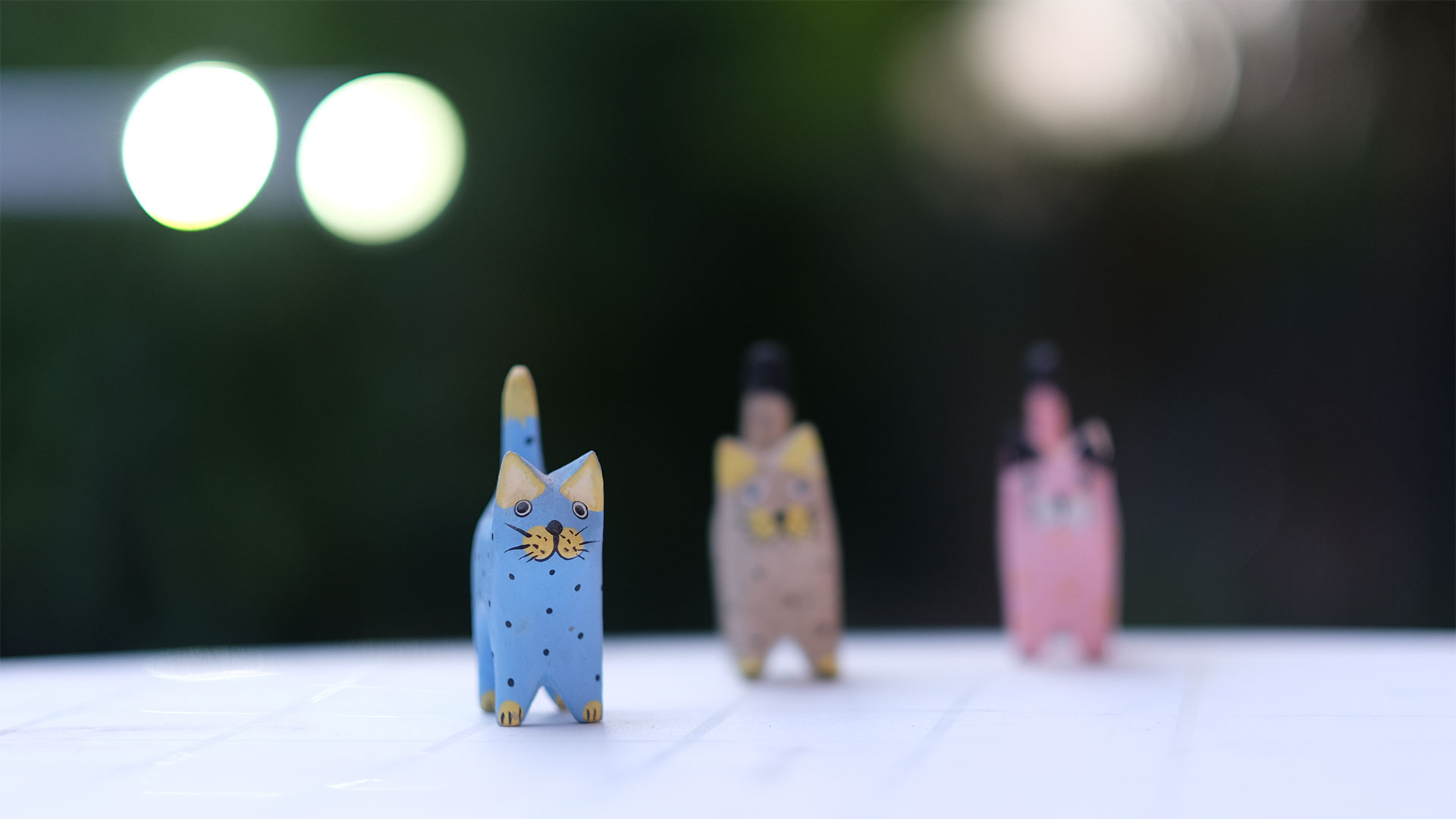 Non smooth bokeh? Fujifilm XF56mm F1.2 R
Non smooth bokeh? Fujifilm XF56mm F1.2 R
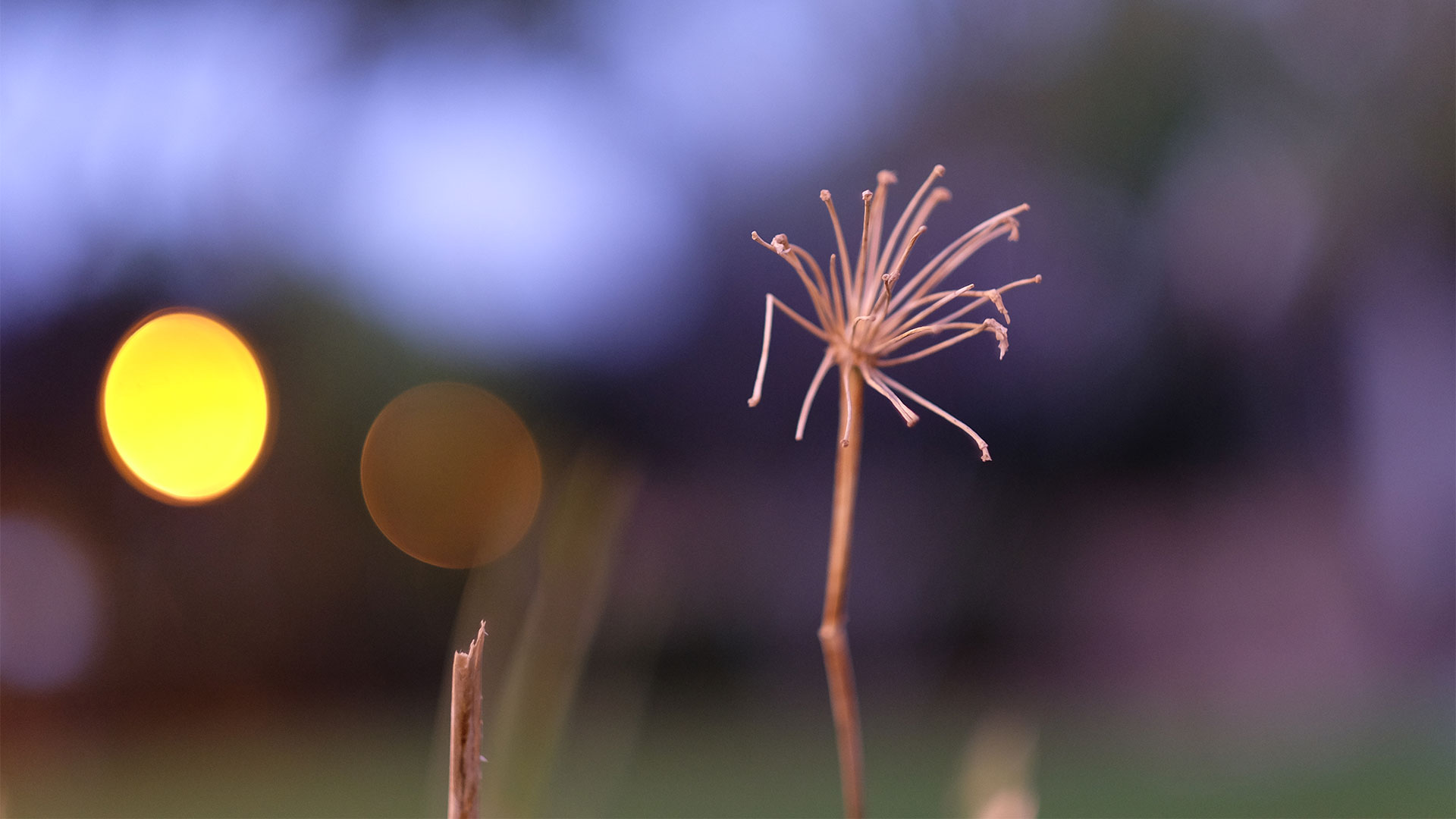 Do you see big differences here? (we don’t), is this representative enough? (we can’t really say), but on a few other examples online we did see some very subtle differences, so it isn’t completely meaningless (even to our not very sensitive eyes).
Do you see big differences here? (we don’t), is this representative enough? (we can’t really say), but on a few other examples online we did see some very subtle differences, so it isn’t completely meaningless (even to our not very sensitive eyes).
AF performance – finally we want to say a few words about AF with the Fujifilm XF56mm F1.2 R APD. With the non APD lens that we played with we had some AF issues (we attribute those to it being a pre production unit). With the APD version we didn’t encounter AF issues in normal light shooting (although the whole AF on Fujifilm cameras is still behind other systems from competing manufacturers such as Sony), however in low light – as expected – the lens with the X-T10 struggled and during the wedding that we shot with it we missed tons of images.
A missed image in low light – one of many
 So if you are thinking of buying this lens for shooting moving subjects in low light – forget about it – get the non APD lens (or a competently different lens/system).
So if you are thinking of buying this lens for shooting moving subjects in low light – forget about it – get the non APD lens (or a competently different lens/system).
Conclusion
Both the regular Fujifilm XF56mm F1.2 R and the APD version are amazing lenses and represent the pinnacle of Fuji’s optical design for its mirrorless line. They are both very compact, very well made and perform superbly in terms of optics (center sharpness wide open is astonishing), and very good in the corners if you are willing to stop down to at least f/4.
When you need to choose between the two, the question that you need to be asking yourself is this – am I willing to pay another $300~ to have improved bokeh (and at least to our eyes – very marginally so) and in return suffer reduced AF performance in low light, extra vignetting and lower light transmission.
Fujifilm XF56mm F1.2 R APD – advantages and disadvantages
 We feels that for the majority of users the answer is no. The extra cost isn’t worth it – not because this is a bad lens (far from it), but because the difference (at least in our eyes) is so small that the drawbacks seems to outweigh the very marginal benefit. We would go as far as to say that even if both lenses would cost the same we would still recommend to most users to get the regular version.
We feels that for the majority of users the answer is no. The extra cost isn’t worth it – not because this is a bad lens (far from it), but because the difference (at least in our eyes) is so small that the drawbacks seems to outweigh the very marginal benefit. We would go as far as to say that even if both lenses would cost the same we would still recommend to most users to get the regular version.
That said, there is a small group of users who might be very “sensitive” to the look of the bokeh and as long as they understand the drawbacks that this lens comes with and are willing to spend the extra $, there is a very good chance that they will enjoy this lens tremendously.
What we liked
- Very high image quality in the center of the frame even wide open.
- High image quality in the corners starting at around f/4~.
- Relatively compact for a f/1.2 lens.
- Great build quality.
- Does create a smoother bokeh (but you need to be a very discerning shooter to notice it).
What we liked less
- The APD reduces the light which reaches the sensor (until f/5.6).
- AF performance in low light takes a big hit.
- Expensive (about $300 more than the regular version which has almost identical performance without the loss of light/AF issues).
Gallery
The following is a gallery of images which we took using the Fujifilm XF56mm F1.2 R APD with the X-T10 camera. Images were not changed apart from cropping.
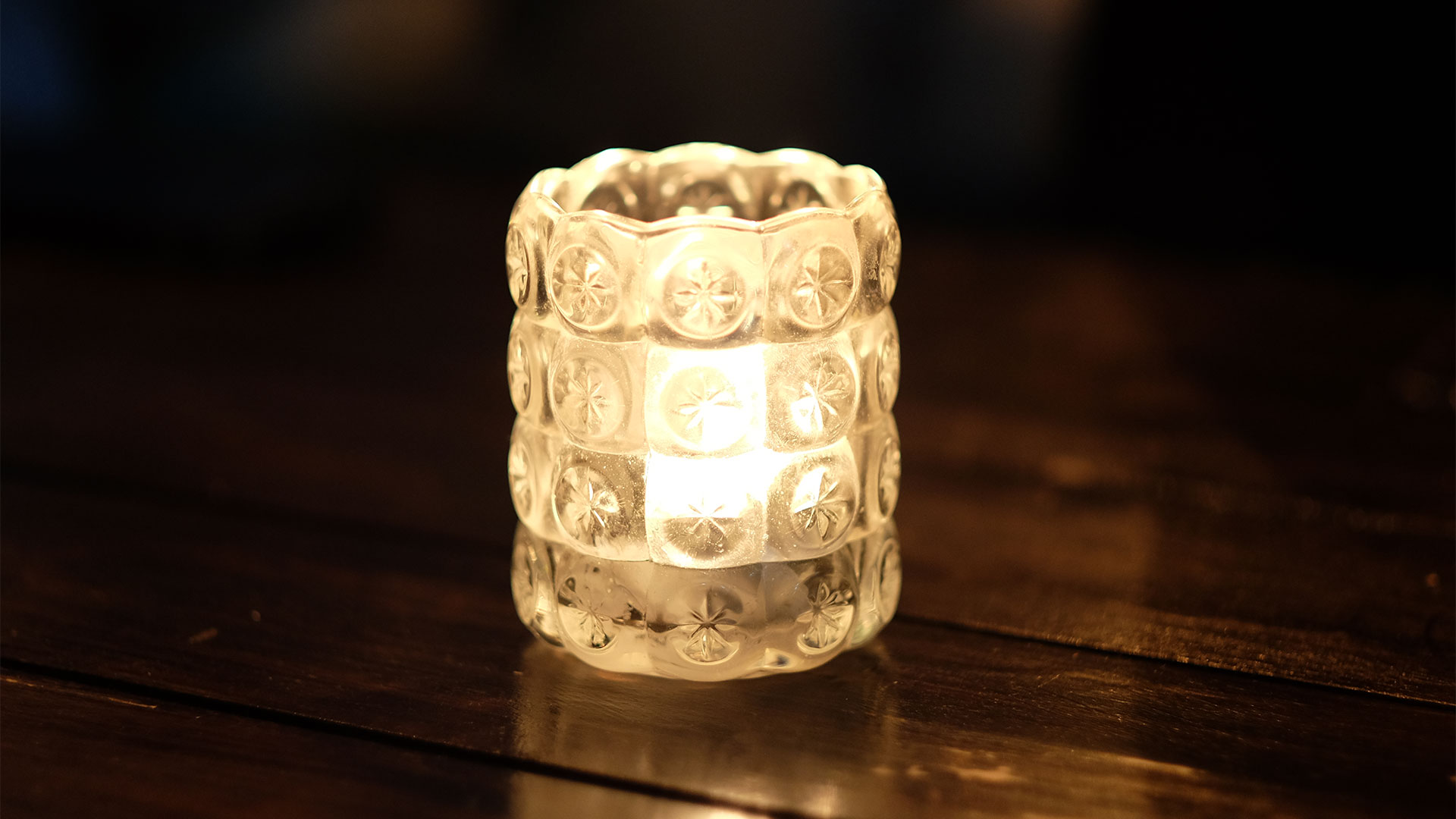 We would like to thank Shimoni group for landing us the camera for review. You can check out more LensVid exclusive articles and reviews on the following link.
We would like to thank Shimoni group for landing us the camera for review. You can check out more LensVid exclusive articles and reviews on the following link.

You can support LensVid by shopping with our affiliate partners
Affiliates: Amazon, B&H, Adorama and E-bay.
Why should you trust us?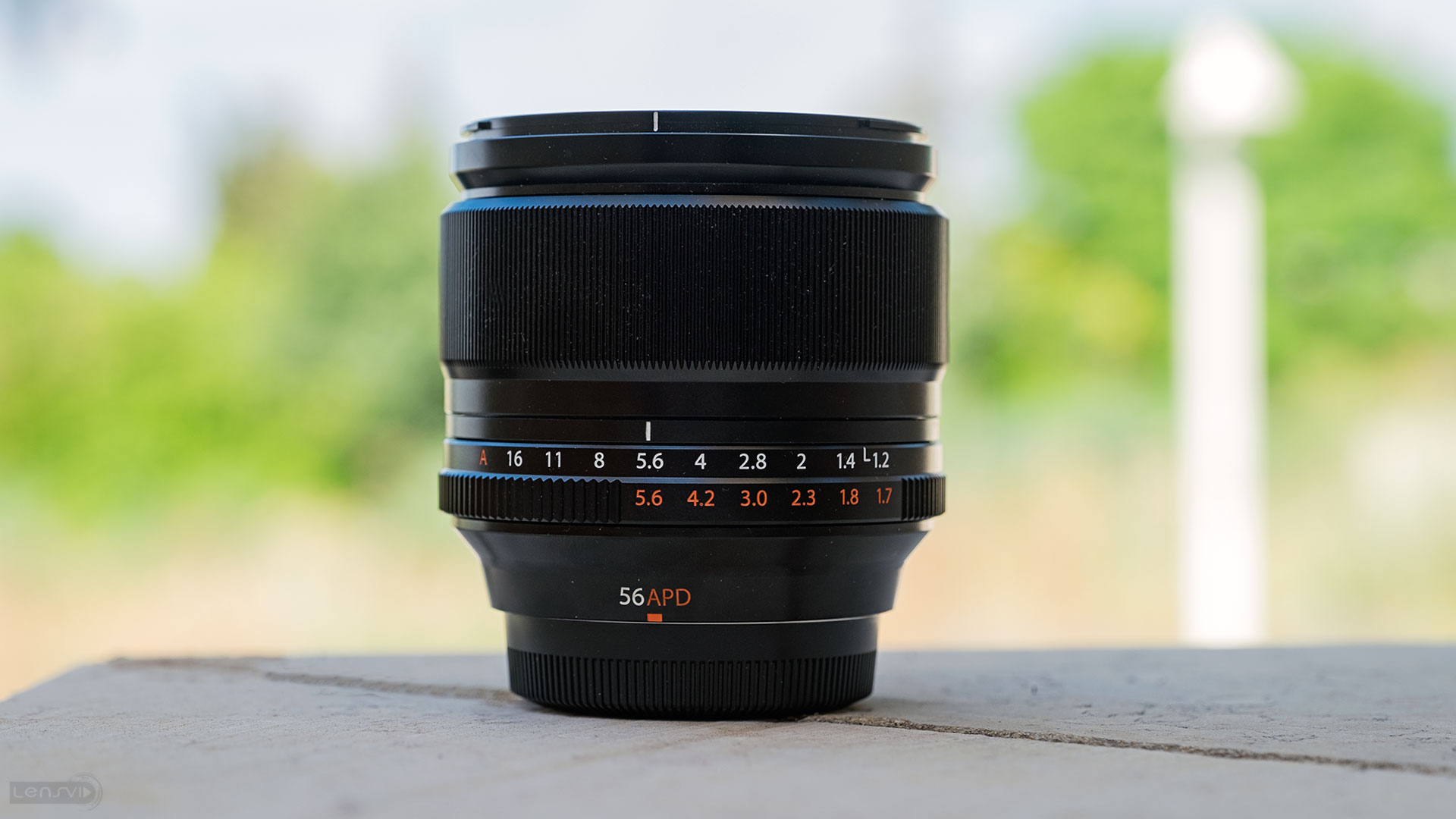






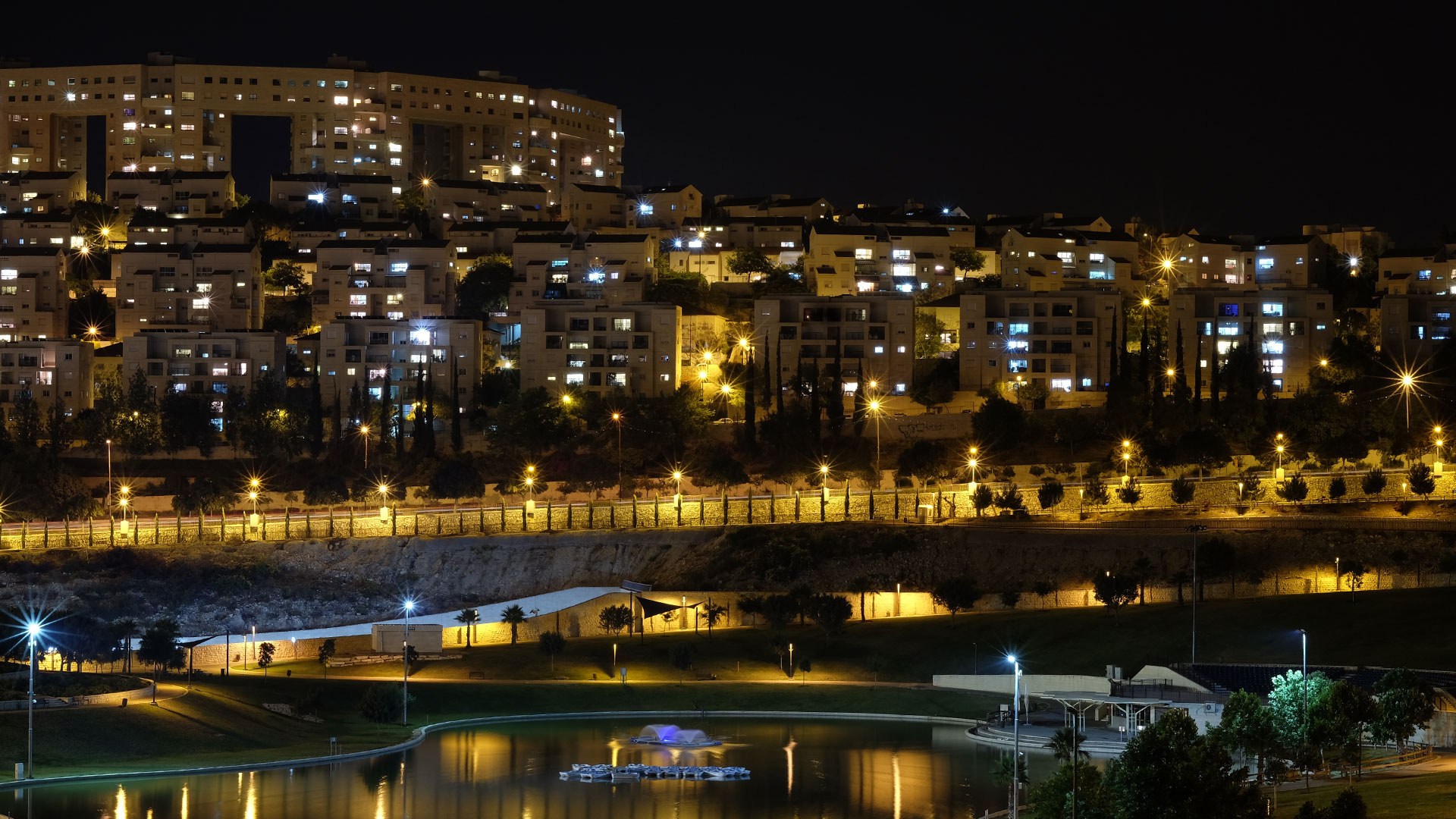
3 comments